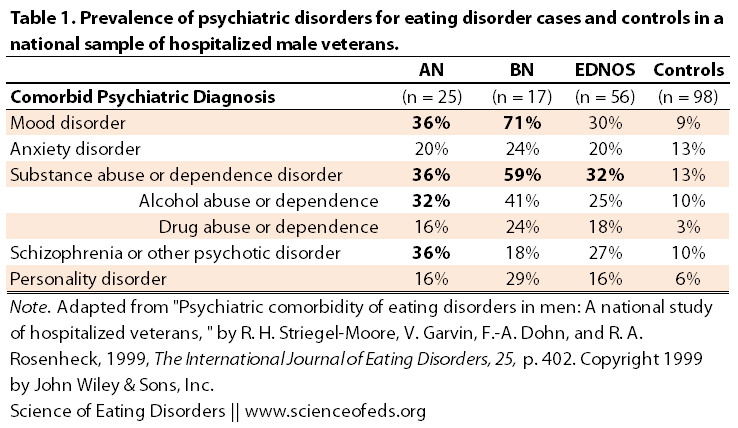Eating disorders don’t discriminate, they just have a bias (more on this in the future). While the majority of eating disorder patients are females, males suffer from eating disorders as well. In fact, it is about, roughly, a 10:1 ratio.
Men tend to just keep quiet about it (and who can blame them, given the stigma women face, it only gets worse for the men.) But, on the inside, their experiences, thoughts, behaviours and recovery span the same spectrum.
There’s relatively little research out there on men with eating disorders, in large part due to the low prevalence rates which makes it harder to get a large enough sample size. So, you have to get creative, as the authors of this study did: they reviewed the prevalence of eating disorders and comorbid psychiatric disorders using data from the Veterans Affairs medical centers of male patients in the fiscal year of 1996. In total: 466,950 males, 0.02% (98) of whom had an ED (using ICD-9-CM criteria). (By comparison, 0.3% of female veterans had an ED, out of 24,041 women.)
Males, just like their female counterparts, also had high rates of comorbid psychiatric disorders. As expected, there are many similarities between women and men when it comes to comorbid disorders. Table 1 outline the prevalence of psychiatric disorders in eating disordered men based on their ED diagnosis (key point: the AN group may include AN patients who binge, although I am unsure about purging status). The authors selected the diagnostic categories (see Table 1) based on previous studies in women (at the time, remember this is 1996).
Demographics (remember, these are veterans):
- Mean ages were: 51.7, 45.6 and 56.7 for AN, BN and EDNOS, respectively
- 86% fell outside of the age considered to be the greatest risk for women developing an ED, 14-40
- 98 men had an ED: 25, 17 and 56 for AN, BN and EDNOS, respectively
- 20%, 23.5% and 17.9% of the men for AN, BN and EDNOS were non-white (!!)
What was surprising to me was the extent of psychiatric co morbidity found in this sample: 92% of AN, 100% of BN and 89.3% of EDNOS cases had at least one psychiatric disorder. The reason I’m surprised is because these numbers mimic female in-patients treated in a residential center, which I hypothesized were inflated in comparison to outpatient or community populations.
.. it is noteworthy that non-white men, who rarely are included in research samples, do suffer from eating disorders….. the occurrence of eating disorders in this middle-aged sample of men highlights the vulnerability to eating disorders in this often overlooked older aged group.
Selected summary of results:
- AN: high rates of mood disorder (consistent with women), substance abuse/dependence disorder (not consistent with reports on women, authors suggest this may be because of overall high rates of substance abuse in this population), schizophrenia or psychotic disorder (this link seems to be replicated in many studies)
- BN: high rates of substance abuse, mood and personality disorders (consistent with findings in women)
- EDNOS also high rates of comorbid psychiatric disorders but rates are more similar to AN
The authors raise some very interesting points when it comes to treatment as well as detection of ED’s in this population. One, EDs may go undetected in patients with substance abuse/dependence. More importantly, the association of schizophrenia/other psychotic disorders with AN, in men, poses some interesting problems for clinician:
How does a clinician distinguish between the morbid fear of fatness characteristic of AN and delusional fears of weight gain that would be more consistent with a psychotic process? How does a clinician tube-feed an emaciated anorexic man who also suffers from paranoid fears of body invasion?
Of course there are limitations in this study, some of which include: older population, small sample sizes, based on clinical diagnosis as opposed to structured interviews.
Nonetheless, the results show very clearly that eating disorders do no discriminate based on gender, race, age or socioeconomic status, and that there are more similarities than differences between men and women, with eating disorders.
References
Striegel-Moore, R.H.,, Garvin, V.,, Dohn, F.-A.,, & Rosenheck, R.A. (1999). Psychiatric Comorbidity of Eating Disorders in Men: A National Study of Hospitalized Veterans International Journal of Eating Disorders, 25, 399-404
